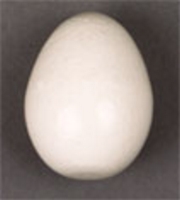Egg Incubation
Pigeon eggs typically hatch on the 18th to 19th day of incubation. The hen lays the first egg then skips one day to lay the 2nd egg  on the third day. I like to see the hen not actually start incubating the egg but just sort of “hover” over the first egg preventing the egg from getting chilled but also not starting the actual incubation process so that when the second egg arrives, they hatch either on the same day or hatch 2 days in a row. on the third day. I like to see the hen not actually start incubating the egg but just sort of “hover” over the first egg preventing the egg from getting chilled but also not starting the actual incubation process so that when the second egg arrives, they hatch either on the same day or hatch 2 days in a row.
When the breeder pair starts to incubate the first egg before the second egg arrives, this can give the first squab to hatch an advantage in size if he should hatch a full day to a day and half before the second egg.
So in this case the first egg to hatch usually has an advantage that can see the second to hatch squab at a size disadvantage in the nest and as the days in the nest go by the size difference can make a huge difference as the larger one tends to get the majority of the food from the parents as he can crowd his smaller nest mate aside. This can lead to malnutrition or retarded growth forcing the fancier to cull this underdeveloped bird.
Sometimes you can swap youngsters in different nests so that the sizes are about the same. This helps assure an equal ability to vie for food from the parents and assure proper levels of nutrition from the breeder pair. Just be sure to keep a record of what squab was moved and who its parents are.
Another technique you can try is to gently remove the first egg and place it in a protected cool dry location and replace it with a wood pigeon egg until the second egg is laid, at this time place the first egg back in the nest and remove the wood egg. Now the eggs should incubate evenly and hatch roughly on the same day.
It is a good set of parents that will feed both youngsters until completely full even with the size difference. This will render the size difference less of a factor in turning out a healthy pair of young birds. Young pairs can have the most difficulty with hovering and incubating properly.
With a little forethought and watching how your pairs do in the breeding pen will give you the information you need to stay on top of the situation.
Tony Chavarria
|